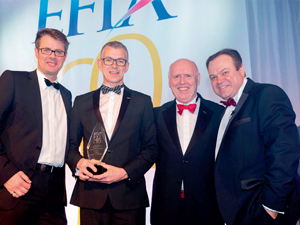 Pinning Technology recognised by association for reducing waste and cleaning intervals
Pinning Technology recognised by association for reducing waste and cleaning intervals
Tokyo Asahi Photoproducts is celebrating its Pinning Technology for Clean Transfer’s receipt of a 2016 Gold Award for sustainable manufacturing and product innovation from the European Flexographic Industry Association (EFIA).
Asahi’s technology is designed to enable kiss touch printing with improved ink transfer and lower ink filling at the mid-tone area, so reduced dot gain, cutting cleaning intervals and waste for improved overall equipment effectiveness (OEE).
“The test press run we performed delivered unequivocal results that validate the value of Asahi plates in an environment where flexographic printers are under increasing pressure to both deliver improved efficiencies and reduce their environmental footprint,” said David Galton, sales director of Asahi Photoproducts Europe.
Asahi conducted the test under controlled conditions to validate the impact of Asahi polymer innovation on overall equipment effectiveness. A single-colour test form was developed that incorporated both vignettes fading to zero and solid coverage. The image was produced using a conventional solvent plate and a Pinning Technology plate on a CI flexo press set to standard printing condition. The same equipment was used for both plates (anilox, tape, ink). The substrate used was OPP film and both tests used a conventional NC solvent-based ink. Results follow:
For the conventional plate, the run length was 37,368 linear m. It took a running time of 173 min. Total press downtime was 47 min for plate cleaning. Waste produced was 1,025m. OEE efficiency was calculated to be 72%. For
the Asahi plates, the run length was 38,000 linear m. It took a total running time of 140 min. Total press downtime was 8 minutes for plate cleaning. Waste produced was 450m. OEE efficiency was calculated to be 91%.
“The printing efficiency of the Pinning Technology for Clean Transfer during this test demonstrates a 26% OEE improvement over conventional solvent plates,” said Galton.
“The significant contributing factors were that the Pinning Technology plate completed the run length 33 minutes faster than the conventional plate.”



